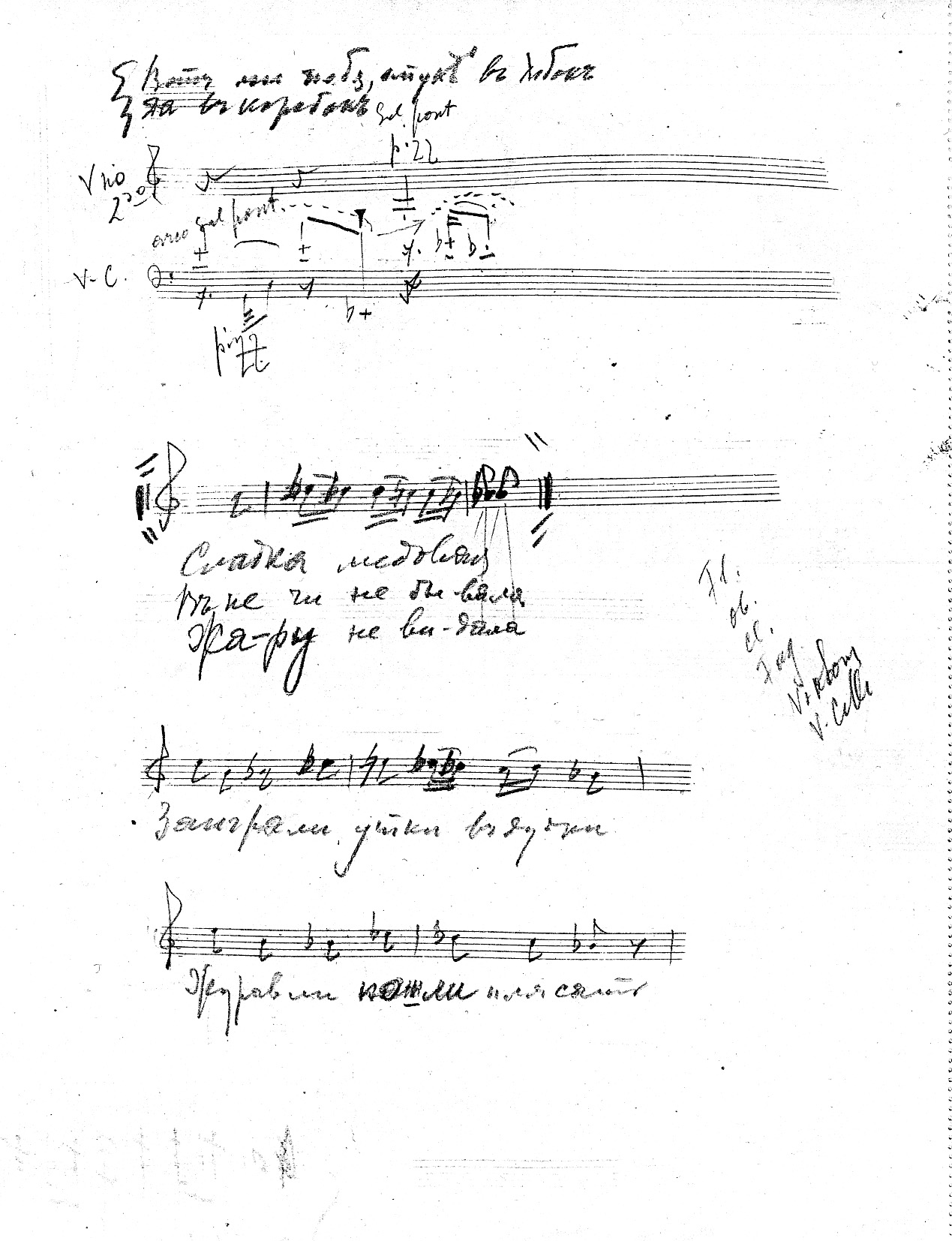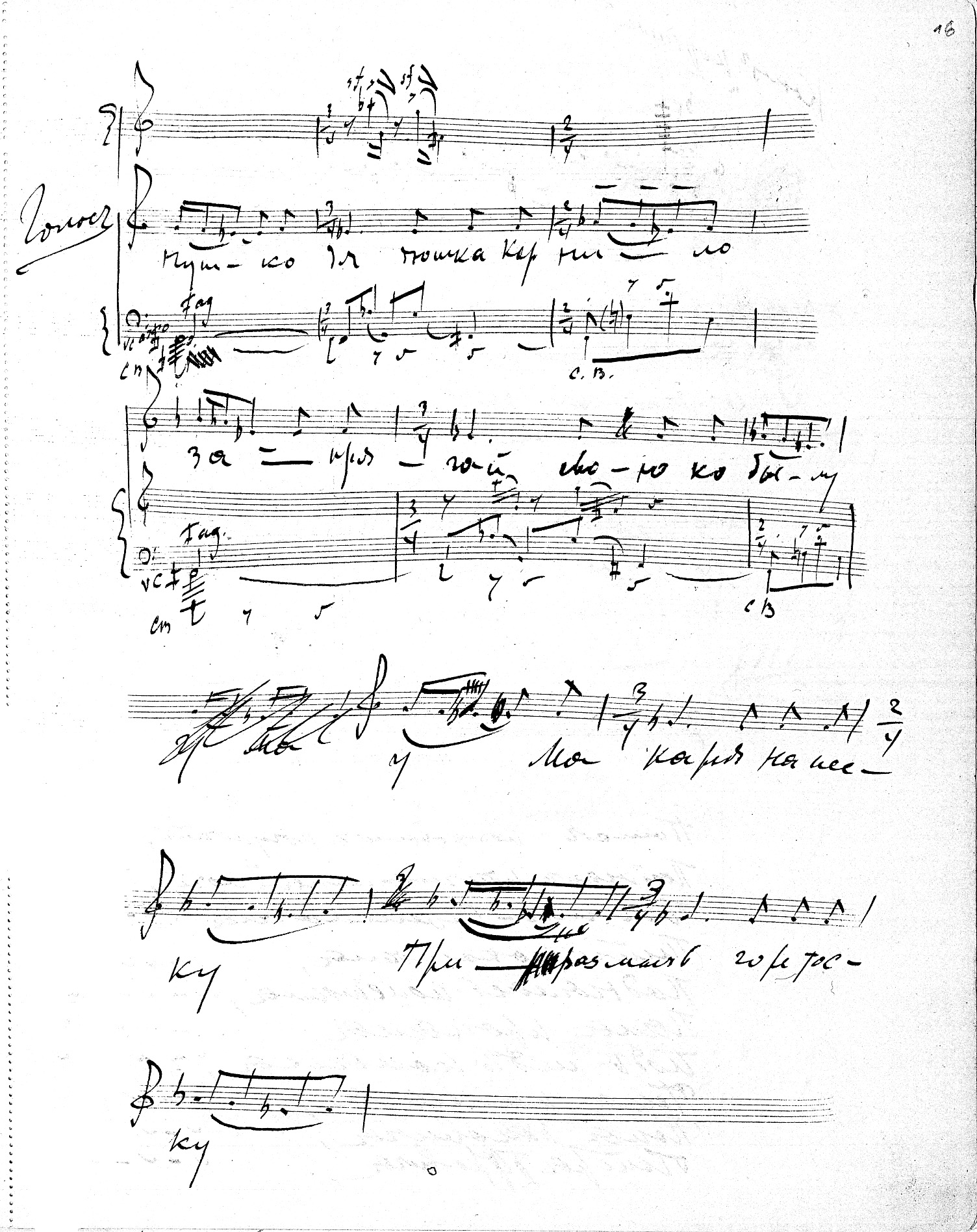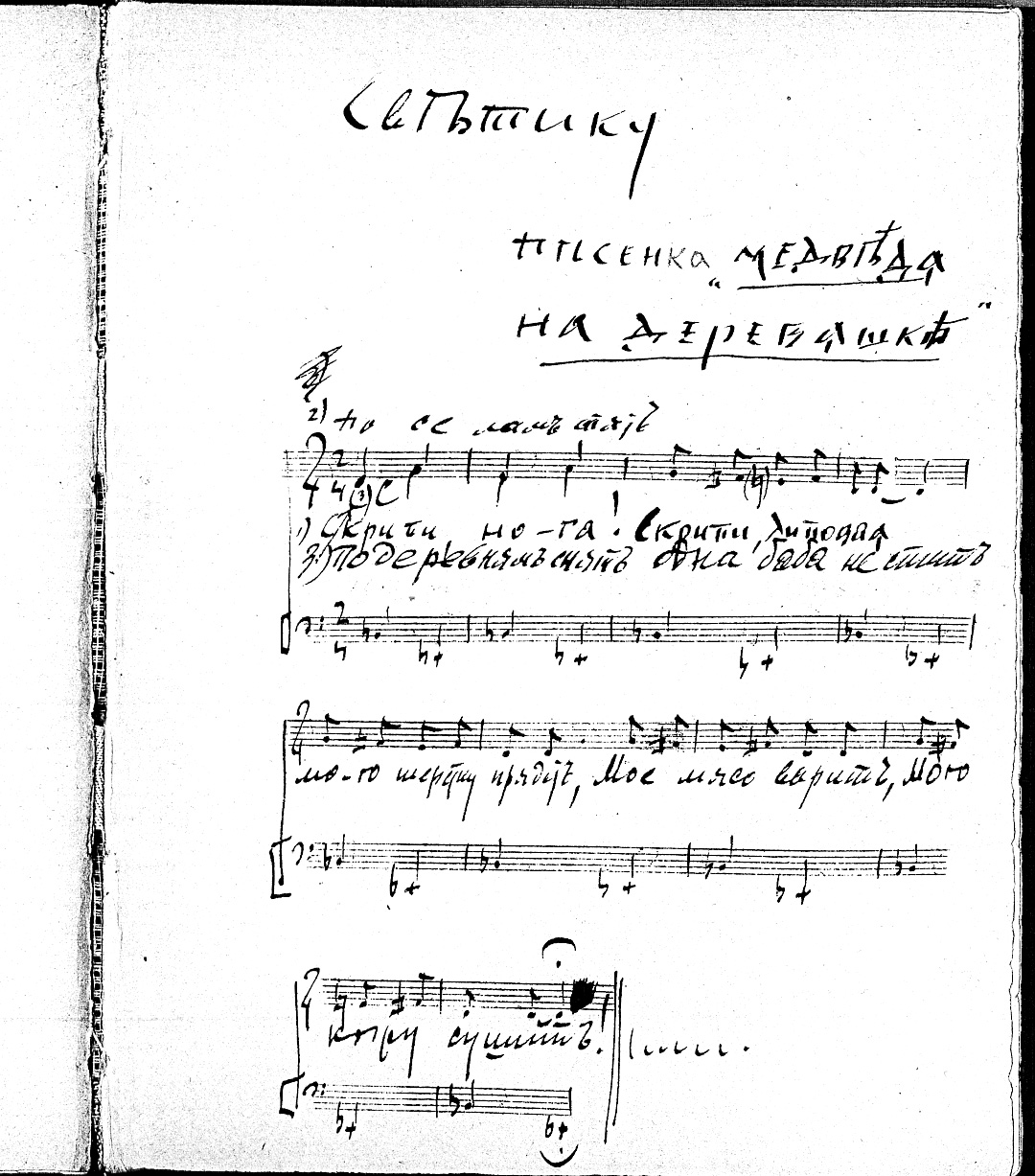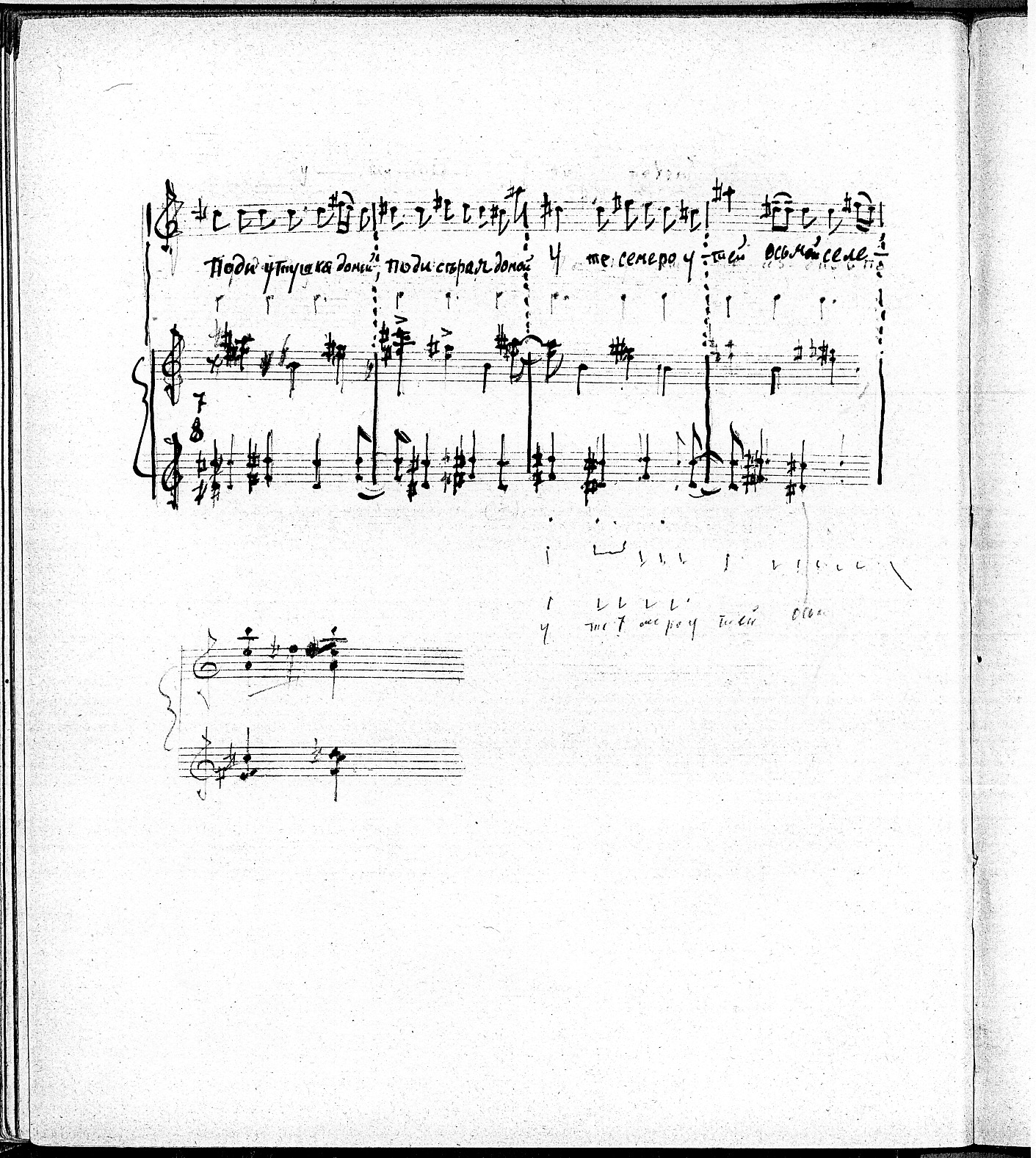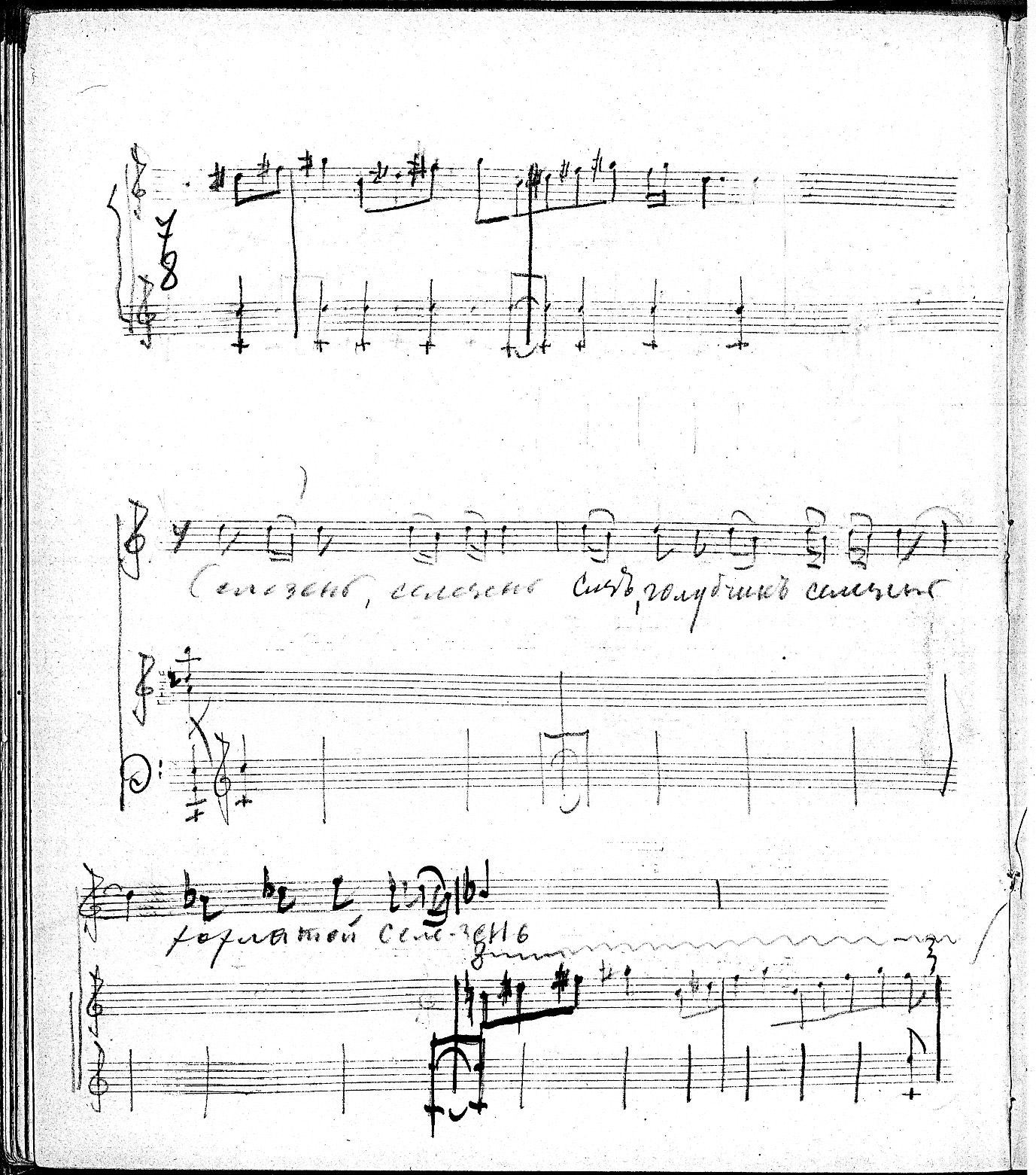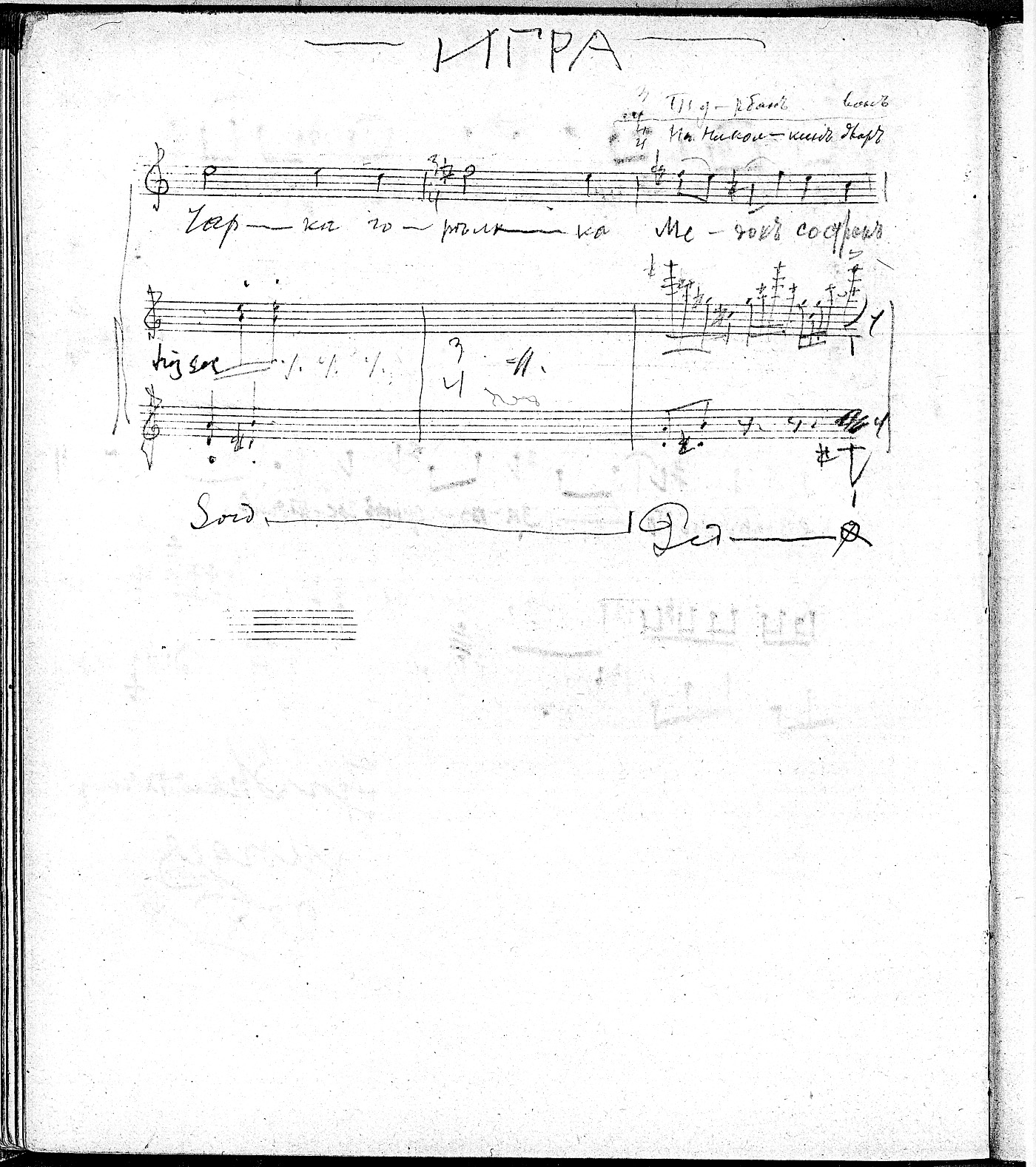The influence of Russian folklore on Stravinsky has been studied in the West from two main perspectives: his reliance on folk melodies (Mazo 1990) and the lack of correspondence between textual and musical accents in his settings (Taruskin 1996). In the paper that follows I concentrate my attention on the second, linguistic aspect of the problem; in particular, the metric organization of Stravinsky’s folk text sources and its influence on his Russian vocal music of the Swiss period (1913–19). The methodological basis for my study is the division of Russian folk verse into regular (consisting of a fixed number of homogenous poetic feet per line, e.g. trochaic tetrameter) and irregular (tonic or accentual verse, featuring a constant number of metrical accents per line but a varying number of syllables between them). The division was proposed by the adherents of the linguistic-statistical method of analysis of Russian folk and literary verse (Tomashevsky 1929, Jakobson 1966 (1929), Taranovsky 1953, Bailey 1993, et seq.). I also share the school’s theory (advanced by Jakobson and Taranovsky, and substantiated by Bailey) that regular poetic metres, notably trochees, are organic to several traditional genres of Russian folklore.1
Such opinion is far from being a predominant one. Russian folk versification has been studied for over 200 years, but there is still no general agreement about its prosodic principles.2 Some researchers think that the rhythm of Russian folk verse is based on both stress and isosyllabism (the constancy of the number of syllables per line); that it, its poetic meter is close to that of literary verse. Others proclaim the importance of stress only, and argue that the tonic (accentual) verse is the only legitimate poetic meter in Russian folklore. Still others assert that folk verse can be isosyllabic, that stress (accentuation) has only secondary importance, and that folk and literary verse do not share any common characteristics. The status quo continues up to the present day, in spite of the fact that the linguistic-statistical approach has already succeeded in determining the structural principles of Russian literary verse with a great certainty (Gasparov 1974, Taranovsky 1953). As Bailey suggests, a similar approach could be adopted by folklorists and ethnomusicologists regarding Russian folk verse (Bailey 2004: 110).
What concerns Stravinsky, his interest in Russian folk poetry was by no means a fugitive one. The son of an operatic singer, whose very last musical œuvre was a song (‘The Owl and The Pussy Cat’, 1969), Stravinsky paid special attention to poetry and to language throughout all of his life. Not only did he set a huge amount of multilingual poetry to music, but also by the 1930s the composer began calling ‘versification’ one of the main principles of his creativity (Lupishko 2005: 11). In this respect, the six years of his Swiss exile (1913–19) can be regarded not only as a preparatory stage to Stravinsky’s neoclassicism of the late 1920s and 1930s, but also as a crucial period in the evolution in his musical thinking, during which the nostalgic immersion of this World War I refugee into Russian folklore was developing into the highly modernist Bayka (Renard), Svadebka (Les noces), and other settings of Russian folk poetry.
What fascinated the composer Stravinsky in his involvement with Russian folk verse was, first and foremost, the very possibility to vary its metric structure in the music. There was an emotional factor as well: in the beginning of his Swiss exile, the 32-year-old Stravinsky wanted, as it were, to reopen access to the magic world of Russian folklore to his own offspring (his youngest daughter Milena was born in January, 1914). The primary impulse came from realizing the fact that in Russian folk verse ‘the accents of the spoken verse are ignored when the verse is sung’ (Stravinsky 1962: 121). Having discovered that folk re-accentuation is an immanent feature of Russian folklore, Stravinsky starts introducing his own unjustified shifts of accents into most of his settings of Russian folk poetry (Lupishko 2007b: 10–31).
This evolution, from ‘primary’ (already existing in the texts) re-accentuation to ‘secondary’ (introduced by the composer) re-accentuation, coincided with another significant one: from the second half of 1914 onwards, the composer starts gradually giving preference to irregular (tonic or accentual) folk verse over regular (mostly trochaic) folk verse. According to Bailey (1993: 210–211), strict and free tonic verse most likely represents the latest stage in the development of Russian folk poetic metres, having evolved from more regular metres like e.g. trochaic tetrameter. A similar evolution, from setting regular trochaic verse (Souvenirs de mon enfance, Pribaoutki, Berceuse du chat, Trois histoires pour enfants) to setting irregular tonic verse (Pribaoutki, Berceuses du chat, Bayka, Podblyudnїe, Quatre chants russes, Svadebka), can be observed in Stravinsky’s settings of Russian folk poetry in 1913–19 (Table 1).
| Folk Trochaic Verse | Folk Tonic Verse |
|---|---|
| 1. ‘The Magpie’ / Souvenirs de mon enfance (1913) | 1. ‘The Colonel’ / Pribaoutki (1914) |
| 2. ‘The Rook’ / Souvenirs… (1913) | 2. ‘The Old Man and the Hare’ / Pribaoutki (1914) |
| 3. ‘Chicher-Yacher’ / Souvenirs… (1913) | 3. ‘The Pike’ / Podblyudnïe (1914) |
| 4. ‘Natashka’ (2nd half) / Pribaoutki (1914) | 4. ‘Mr. Portly’ / Podblyudnïe (1915) |
| 5. ‘Kornilo’ / Pribaoutki (1914) | 5. ‘Kot na pechi’ / Berceuses du chat (1915) |
| 6. ‘U kota, kota’ / Berceuses du chat (1915) | 6. ‘Bay-bay’ / Berceuses… (1915) |
| 7. ‘The Bear’ / Trois histoires pour enfants (1915) | 7. ‘Spi, kot’ / Berceuses… (1915) |
| 8. ‘Tilim-bom’ / Trois histoires… (1917) | 8. ‘U Spasa v Chigisakh’ / Podblyudnïe (1916) |
| 9. ‘Gusi-lebedi’ / Trois histories… (1917) | 9. ‘Ovsenʹ’ / Podblyudnïe (1917) |
| 10. ‘The Drake’ (2nd half) / Four Russian Songs (1918) | 10. ‘The Sparrow’ / Four Russian Songs (1919) |
| 11. ‘A Song for Counting’ (2nd part) / Four Russian Songs (1918) | 11. ‘A Russian Spiritual’ / Four Russian Songs (1919) |
Before discussing the content of the first column in detail (the discussion of the second column could be a subject of a separate paper), a theoretical digression into the area of silent syllable poetic feet (incomplete feet) is necessary. Although extremely widespread in ‘happy and rapid’ folk songs, incomplete feet as applied to Russian folklore have never been the subject of a separate investigation, for the very existence of homogeneous poetic feet in Russian folk verse is still put into doubt by many linguists. This is why the author of the present study had to rely on the generative linguistic studies of English quatrain stanzas (Hayes, MacEachern 1998), as well as on the two pioneering comparative studies of children’s folklore (Burling 1966, Brailoiu 1973). Below I show four instances of incomplete feet in Russian folk children’s verse (Shein 1989: 33–4; ‘S’ = strong syllable, ‘w’ = weak syllable, reaccented vowels are shown in capital letters):
| (a) | Дождик, дождик, пуще, | Dózhdik, dózhdik, púshche, | Sw | Sw | Sw | → Sw Sw S S |
| Дадим тебе гущи | DAdim tébe gúshchi | Sw | Sw | Sw | → Sw Sw S S | |
| (b) | Тилим-бом, тилим-бом, | Tílim-bóm, tílim-bóm, | Sw | S | Sw | S |
| Загорелся козий дом. | ZAgorélsia kózii dom. | Sw | Sw | Sw | S | |
| (c) | Трах, трах, тарарах! | Trakh, trakh, tararákh! | S | S | Sw | S |
| Едет баба на волах. | Édet bába na volákh. | Sw | Sw | Sw | S | |
| (d) | Уж дождь дождём, | Uzh dozhdʹ dozhdyóm, | S | S | S | S |
| Поливай ковшом! | Polivái kovshóm! | Sw | S | S | S |
In Example (a), the trochaic trimeter of the poem musically (and rhythmically, if the verse is simply spoken) functions equally well as a trochaic tetrameter with two incomplete feet at the end of each line. The reason for such an extension is universal: as Burling 1966 and Brailoiu 1973 have shown, a four-beat poetic line is the most typical feature of the children folklore worldwide, regardless of the actual poetic metre of the verse (iamb, trochee, amphibrach, etc.). In the first line of Example (b), complete feet (Sw) alternate with incomplete feet (S) in the most natural way, creating a necessary pause after each ‘bom’ (the droning sound). In Example (c), although each line contains only three stresses, the verse itself is trochaic: ‘tararách’ and ‘na volákh’ rhyme to form two poetic feet each, while the rumbling sound of ‘Trakh, trakh, tararákh’ necessitates pauses after each ‘-akh’. Lastly, in the first line of Example (d)3 all poetic feet are shown as incomplete. They can be considered incomplete only if the rest of the poem develops and expands the initial four-beat metric carcass. And it does: the second line is one syllable longer than the first. If taken separately, this line contains only two stresses (‘Polivái kovshóm’); however, the ‘extra’ syllable creates a complete trochaic foot in the beginning of the line. This trochaic foot imparts a so-called ‘trochaic momentum’ onto the rest of the verse which continues to ‘thread’ such slightly expanded lines onto the four-beat carcass (cf. my analysis of ‘Grib-borovik’ and ‘Chicher-Yacher’ below).
Here is one more example of this expansion: the first line contains one silent foot (Ø), the second line adds one extra syllable to the four-beat metric carcass, and the rest of the poem continues in a ‘Tilim-bom, tilim-bom’ type of trochaic tetrameter. This Example (e) also illustrates the importance of analyzing poetic lines within the context of the verse:
| (e) | Волк-волчок, | Volk-volchók, | Ø | S | S | S |
| Шерстяной бочок, | Sherstyanói bochók, | Sw | S | S | S | |
| Через ельник бежал, | Cherez élʹnik bezhál, | Sw | S | Sw | S | |
| В можжевельник попал, | V mozhzhevélʹnik popál, | Sw | S | Sw | S | |
| Зацепился хвостом, | Zatsepílsya khvostóm, | Sw | S | Sw | S | |
| Ночевал под кустом. | Nochevál pod kustóm. | Sw | S | Sw | S |
The issue of silent syllable feet (and silent feet) is a very complex interdisciplinary problem because it touches upon the durational aspect of poetry, an area that is open for subjective interpretations, as the duration of the sounding poem is not directly reflected in the published poetic text. This issue is part of a bigger and more difficult problem raised in this paper, the problem of comparison between musical and verbal rhythms. Do they correspond, and are they supposed to correspond in any way? My present study is not meant to clarify the theoretical matter of correspondence between musical and verbal incomplete feet as applied to Russian folklore (although, to my knowledge, it has not been done yet in any systematic way). Instead, I want to investigate the instances of close correspondence between the verbal rhythm, the ‘hypothetic verbal/musical rhythm’ (i.e. the way the folksinger would treat the verbal rhythm), and the actual musical rhythm of the published score in order to prove the existence and the prevalence of the ‘incomplete-foot-conscious’ method of text-setting in Stravinsky’s Russian vocal music of the Swiss period.
In my analysis of Stravinsky’s settings of Russian folk trochaic verse, I notice that certain trochaic patterns are more common there than others. Below I give a presentation of the most favoured trochaic patterns of Stravinsky’s Russian vocal cycles of the Swiss period (1913–19). Russian folk trochaic verse taken by Stravinsky comes principally from two closely related genres of Russian folklore: children’s songs and skazovy stikh (spoken verse, where the subject matter is not for children). The table overleaf gives some idea of the frequency of incomplete feet in these two genres of Russian folklore, as well as about the existence of the ‘well-formed’ trochaic stanzas in any folk poetry in general, both of which can be of interest to metrists and verse specialists from any linguistic background.4 What is more important for Russian musicologists and ethnomusicologists, is that most of these variants are represented with a higher or lesser degree of exactness in Stravinsky’s music – a fact that allows one to suspect a more or less conscious approach on his part. In Table 2 overleaf, the numbering refers to the quantity of omitted weak syllables in a single line,5 ‘S’ corresponds to strong syllable, ‘w’ to weak syllable, Roman numerals refer to the analysis of individual songs below, reaccented vowels are shown in capital letters, and the lines of which the hypothetic verbal/musical metre is somewhat distorted in the music are shown in grey. It should be stressed again and again that my attribution of all these lines to the trochaic tetrameter can be debatable if these lines are taken out of the context of the verse (for an alternative analysis see my fn. a–h, Table 2).
| 0. | Sw | Sw | Sw | Sw | Под мостом ворона сохнет | Pod mostóm voróna sókhnet | (III) |
| Заиграли утки в дудки | Zaigráli útki v dúdki | (V) | |||||
| Ну-тко, дядюшка Корнило | Nu-tko, dyádyushka Kornílo | (VI) | |||||
| Гуси-лебеди летили (sic) | Gúsi-lébedi letíli (sic) | (IX) | |||||
| 1a. | Sw | Sw | Sw | S | Над грибами полковик | Nad gribámi polkovík | (I) |
| Сороченька, чи-чи-чи | SOrochenʹka, chi-chi-chí | (II) | |||||
| Еду как-то я на мост | Édu kak-to ya na most | (III) | |||||
| Собирался на вечерa | Sobirálsya nA vecher | (IV) | |||||
| Журавли пошли плясать | Zhuravli poshli plyasatʹ | (V) | |||||
| У Макарья на песку | U Makárʹya na peskú | (VI) | |||||
| А у дитятки мово | A u dítyatki movó | (VII) | |||||
| Загорелся козий дом | Zagorélsya kózii dom | (VIII) | |||||
| Воробей дрова колол | Vorobéi drová kolól | (XI) | |||||
| Поди, утушка, домой | Pódi, útushka, domói | (XI) | |||||
| 1b. | Sw | Sw | S | Sw | Вскочила на ёлочкуb | VskOchila na yólochku | (II) |
| 2a. | Sw | S | Sw | S | Под грибом сидючи | Pod gribOm sidyuchI | (I) |
| Тилим-бом, тилим-бом | Tilim-bóm, tilim-bóm | (VIII) | |||||
| И получше того | I polúchshe tovó | (VII) | |||||
| Коза выскочила | KOza vyskochila | (VIII) | |||||
| Вошка парилася | Vóshka párilasya | (IX) | |||||
| Скрипи, липоваяc | SkrIpi, lípovaya | (X) | |||||
| 2b. | Sw | Sw | S | S | Пусть ворона сохнетd | Pustʹ voróna sókhnet | (III) |
| 2c. | S | Sw | Sw | S | Селезень, селезеньe | Sélezenʹ, selezEnʹ | (XI) |
| 3a. | Sw | S | S | S | Тащит лесенку | Táshchit lésenku | (VIII) |
| И земля-то спит | I zemlyá-to spit | (X) | |||||
| Осьмой селезень | Osʹmoi sélezenʹ | (XI) | |||||
| На Николкин дворf | Na Nikólkin dvor | (XII) | |||||
| 3b. | S | S | Sw | S | Гриб, гриб боровик | Grib, grib borovík | (I) |
| 3c. | S | Sw | S | S | Чарка-горелка | Chárka-gorélka | (XII) |
| 4. | S | S | S | S | Чичер-Ячерg | Chícher-Yácher | (IV) |
| Скрипи, нога | Skripí, nogá | (X) | |||||
| Медок-сострокh | Medók-sostrók | (XII) |
- If this line is taken out of the context, it is a trochaic trimeter with a dactylic ending: Sw Sw Sww.
- Out of context and with all the literary accents intact, it is an amphibrachic dimeter: wSw wSw.
- All the lines of the trochaic type 2a are anapestic dimeters: wwS wwS.
- This is a trochaic trimeter: Sw Sw Sw.
- This is a dactylic dimeter: Sww Sww.
- All the lines of the trochaic type 3a are trochaic dimeters with a dactylic ending: Sw Sww.
- This line is a trochaic dimeter.
- The remaining two lines of the trochaic type 4 are iambic dimeters.
Before discussing some of these trochaic types, I would like to draw attention to the following two points: (1) these various types of the trochaic tetrameter do exist in the text sources chosen by the composer, and (2) Stravinsky is aware of the existence of incomplete feet in Russian folk trochaic verse not only because he chooses for his settings multiple metric variants of the basic trochaic tetrameter (Sw Sw Sw Sw), but also because he often reflects them directly in his settings, usually assigning a crotchet to an incomplete foot and two quavers to a complete foot.
I. ‘Kak gribї na voynu sobiralisʹ’ / ‘How the Mushrooms Prepared for War’ (1904)
The most interesting proof of this last idea is found in the setting of the second refrain of this early song that is not included in Table 1 above. Here the 22-year-old composer straightens out the text source by inserting one more ‘grib’ in order to get a full-scale trochaic tetrameter in the second refrain. Curiously, in this song, both full (3b) and truncated types of trochaic tetrameter coexist on equal terms; in other words, in this early opus the composer pays attention to a metric irregularity of Russian folk verse but leaves it as it is in one instance out of the two:
| 1. | Гриб боровик, | Gríb borovík | Ø | S | Sw | S | Refrain 1 |
| 1. | Гриб гриб боровик, | Gríb gríb borovík | S | S | Sw | S | Refrain 2 |
| 1. | Гриб боровик, | (Gríb) grib borovík, | (S) | S | Sw | S | |
| 2. | Над грибами полковик, | Nad gribámi polkovík, | Sw | Sw | Sw | S | |
| 3. | Под дубом сидючи, | Pod dubóm sidyuchí, | Sw | S | Sw | S | |
| 4. | На грибы глядючи, | Na griby glyadyuchí, | Sw | S | Sw | S | |
| 5. | Повелел, приказал | Povelél prikazál | Sw | S | Sw | S | |
| 6. | Всем грибам на войну идти. | Vsem gribám na voynú idtí. | Sw | S | Sw | Sww |
Taruskin established that the original text source came essentially from the Guselʹki (The Little Psalterion) anthology, a collection of 128 songs for schoolchildren with simple piano accompaniment (Taruskin 1996: 142). It was conflated by Stravinsky with a similar prosaic text found in the anthology of Russian folk tales by Alexander Afanasiev (1957 I, No. 90), the text source of Pribaoutki, Trois histoires pour enfants, Bayka, and Histoire du soldat. The first refrain consists of six lines with masculine endings. The anapestic dimeter is evident in lines 1, 3, 4, 5, and 6; however, the metric structure of the second line contradicts to some extent this tendency. In the second line the metric ‘feel’ is clearly four-fold, not two-fold. Because this line is the first fully complete one, it establishes the poetic metre for the rest of the poem. Its metric ‘momentum’ is so strong that lines 3, 4, and 5 are likewise ‘felt’ as consisting of four main beats per line, not two.6
In Guselʹki, the first line of the refrain is shorter than the metric norm of the poem and also ‘feels’ somewhat incomplete (Taruskin 1996: 140–1). Perhaps it ‘felt’ the same to Stravinsky; otherwise he would not have added one more ‘grib’ into the second refrain to straighten out this line (Example 1A, mm. 30–31, see also the scheme above):

The fact of lengthening of the first line of the original text source proves that the composer was aware of the phenomenon of incomplete feet, even though he might have never become fully conscious about it. By repeating the word ‘grib’, the composer has achieved an isometric similarity of the first line with the second; in other words, he realized that adding just one more syllable would be enough to produce a full-scale trochaic tetrameter.7
Just as thoroughly, Stravinsky confirms the trochaic tetrameter in his settings of the second line of the poem (Example 1B, mm. 2–4). Actually, exactly the same rhythmic layout is also found in the first eight measures of the setting in Guselʹki (Taruskin 1996: 140–1):

II. ‘Sorochenʹka’ / ‘The Magpie’ from Souvenirs de mon enfance (1913)
According to Vershinina (Stravinsky 1982 I: 194), it is possible that the tunes of the songs of this cycle, together with ‘How the Mushrooms Prepared for War’ (1904) and the lost ‘The Driver and the Tarantula’ (1906), belong to the group of ‘little comic songs’ written by the composer during his private studies with Rimsky-Korsakov. Therefore, it is not surprising that the principle of nearly absolute correspondence between poetic and musical metre and rhythm is observed in this cycle as well. The first song is the clearest embodiment of this principle. The text is a trochaic tetrameter in the first two lines, a trochaic trimeter with dactylic endings in lines 3–6 (trochaic shifts are shown in capital letters):
| 1. | Сороченька, чи, чи, чи, | SOrochenʹka, chi, chi, chí, | Sw Sw Sw S |
| 2. | На ёлочку не скачи. | NA yólochku ne skachí. | Sw Sw Sw S |
| 3. | Вскочила на ёлочку, | VskOchíla na yólochku, | Sw Sw Sww → Sw Sw S Sw |
| 4. | Сломила головушку. | SlOmíla golóvushku. | Sw Sw Sww → Sw Sw S Sw |
| 5. | Дайте мне верёвочку | Dáite mne veryóvochku, | Sw Sw Sww → Sw Sw S Sw |
| 6. | Завязать головушку. | ZAvyazátʹ golóvushku. | Sw Sw Sww → Sw Sw S Sw |
The composer reads this poem as any child would do – as a trochaic tetrameter – and distributes uneven hemistiches into even 2/4 measures. What is more interesting is that here Stravinsky creates two different types of the trochaic tetrameter: compare Sw Sw Sw S (type 1a) of lines 1–2 and Sw Sw S Sw (type 1b) of lines 3–6 (Example 2, cf. mm. 3, 5 and 7, 9):

The musical setting could go as a very conventional Sw Sw Sw S up to the end, but the composer decided to experiment with the distribution of syllables into poetic feet. Such a change of the trochaic type was not purely arbitrary since, by having done this, Stravinsky actually ‘acknowledged’ the correct literary accents in lines 3–6 (yólochku, golóvushku).8
III. ‘Vorona’ / ‘The Rook’ from Souvenirs de mon enfance
The verse (whose genre is an endless fairytale) is an ordinary trochaic tetrameter. As in the first song, the overall metric balance is created here by the interchange of masculine endings with feminine endings. The composer follows this logic strictly (Example 3):
| 1. | Еду как-то я на мост, | Édu kak-to ya na most, | Sw Sw Sw S |
| 2. | На мосту ворона сохнет. | Na mostú voróna sókhnet. | Sw Sw Sw Sw |
| 3. | Хвать ворону я за хвост, | Khvatʹ vorónu ya za hvost, | Sw Sw Sw S |
| 4. | Положил ее под мост – | Polozhíl ee pod most – | Sw Sw Sw S |

Feeling the urge to destroy monotony, Stravinsky (most likely working from memory, since no published text sources for Souvenirs were at his possession at the time he finished the score in 1913 in Clarens) skips the word ‘sebé’ in lines 11 and 12, thus refusing one of the folk text variants ‘Pustʹ sebé voróna móknet’ (Sw Sw Sw Sw). In Stravinsky’s hands, the actual trochaic trimeter of these two lines is sacrificed for a new type of the trochaic tetrameter with two incomplete feet at the end, type 2b (Ex. 3, mm. 13–16).
Another interesting detail of this song is that the two identical poetic lines are not identical in the music. The first ‘móknet’ is represented by a dotted-note rhythm, while the second ‘móknet’ falls on two even crotchets. The re-accentuation of one and the same word, ‘móknet – moknEt’ (and also ‘sókhnet – sokhnEt’), is made more pronounced by the melodic leap from A1 to C2 on the second word (Ex. 3, cf. mm. 14 and 16; cf. S and S below):
| 5. | Пусть ворона мокнет, | Pustʹ voróna móknet, | Sw Sw Sw → Sw Sw S S | type 2b |
| 6. | Пусть ворона мокнет. | Pustʹ voróna moknEt. | Sw Sw Sw → Sw Sw S S | type 2b |
The corresponding page in Sketchbook I in Stravinsky’s archive in Basel (folio 123-0035, Figure 1) confirms our intuition that the initial impulse for this work was this shift of accents of one and the same word. The top of the page 123-0035 gives the vocal part only of mm. 13–16 with no text. The first ‘moknet’ is a dotted-crochet rhythm, while the second is represented as a crotchet and a quaver with a quaver rest.
IV. ‘Chicher-Yacher’ from Souvenirs de mon enfance
Stravinsky attributes this setting to the genre of counting-game songs (Stravinsky, Craft 1962: 121). Indeed, one can easily imagine a group of four children standing in a circle; one of them starts to count, pointing to a new participant with every new syllable: ‘Chi-cher, Ya-cher…’ The four children personify trochaic feet, and this is a visual demonstration of what happens metrically in this poem:
| 1. | Чичер-Ячер | Chícher-Yácher | S | S | S | S | type 4 |
| 2. | Собирался на вечер. | Sobirálsya nA vecher. | Sw | Sw | Sw | S | |
| 3. | Чичер-Ячер | Chícher-Yácher | S | S | S | S | type 4 |
| 4. | Загонял всех на вечер. | Zagonyál vsekh nA vecher. | Sw | Sw | Sw | S |
As any Russian child, Stravinsky also views this verse as a trochaic tetrameter with incomplete poetic feet in every position (type 4) in odd lines (Example 4, mm. 1–4):9

V. ‘Natashka’ from Pribaoutki (1914)
As seen from the dates on the final sketch, the second song ‘Natashka’ was written first, and the first song ‘Kornilo’ second, with only a few days between them (August 13 and 18, 1914). In the draft, Stravinsky wrote the text down like a poem instead of a paragraph of prose, as does Afanasiev (1957 III, No. 550). The first half is labeled erroneously in his hand ‘dactili’ (recte amphibrachs), the second – ‘jamb’ (recte trochee) (Taruskin 1996: 1170; Lupishko 2005: 10). The music is set accordingly: the first half to the 3/8 metre with a quaver upbeat (Allegro), the second – to 2/4 Meno mosso. Although the first part of the text of ‘Natashka’ is an amphibrachic dimeter (and as such it lies outside the scope of the present paper), there is an interesting detail connecting it with ‘Vorona’ / ‘The Rook’ discussion above: the initial impulse came from the text. The first page of Sketchbook II that gives the beginning of Pribaoutki, 123-0077 (Figure 2), features the setting of these three lines with their immanent shifted stresses (shown in capital letters):
| 3. | Сладка медовая, | Sladká medovAya, | wSw wSw |
| 4. | В печи не бывала, | V pechí ne byvála, | wSw wSw |
| 5. | Жару не видала. | ZharU ne vidála. | wSw wSw |
In the second half of the song, the verse becomes a trochaic tetrameter with alternately masculine and feminine endings. The setting of lines 6 and 7 are given on the same page of the sketchbook. The inspiration from poetry is obvious: the music for the second feminine-ending line is written strictly under the first masculine-ending one (Figure 2; Example 5, mm. 11–14):

| 6. | Заиграли утки в дудки, | Zaigráli útki v dúdki, | Sw Sw Sw Sw |
| 7. | Журавли пошли плясать, | Zhuravlí poshlí plyasátʹ, | Sw Sw Sw S |
VI. ‘Kornilo’ from Pribaoutki
Unlike the heterogeneous text of ‘Natashka’, the text of ‘Kornilo’ is fully a trochaic tetrameter. ‘Kornilo’ is a more interesting setting than ‘Natashka’ because the musical rhythm here complicates significantly the poetic metre of the text. In fact, what happens here can be called a melismatic extension of the four-foot trochee into a seven-foot trochee. A similar phenomenon can be encountered in Russian folk songs where certain stressed syllables are prolonged melismatically (i.e. set to three different pitches) three times in comparison with other syllables. The well-articulated melisma ‘á-a-á’ thus metrically represents one and a half trochaic feet in the place of one strong syllable (Sw S instead of S, see the scheme below). In the Russian folk drawn-out song ‘Vniz po matushke po Volge’ / ‘Down the mother-river Volga’, such a triple prolongation of ‘Vni-’ ‘ma-’ and ‘-ke’ turns the poetic four-foot trochee into a musical eight-foot trochee (Propp 1961: 45):
| Вниз по матушке по Волге | Sw | Sw | Sw | Sw |
| Vniz po mátushke po Vólge | ↕ | ↕ | ↕ | ↕ |
| Вни-и-из по ма-а-атушке-е-е по Волге | Sw Sw | Sw Sw | Sw Sw | S | S |
| Vní-i-íz po má-a-átushké-e-é po Vól|gé |
Here is the text of ‘Kornilo’ as it appears in Afanasiev (1957 III, No. 543I). In the first half of the song, each line of the text corresponds to three measures of the music (Example 6):
| 1. | Ну-тко, дядюшка Корнило, | Nú-tko, dyádyushka Kornílo, | Sw Sw Sw Sw |
| 2. | Запрягай-ко ты кобылу, | Zapryagái-ko ty kobylu, | Sw Sw Sw Sw |
| 3. | У Макарья на песку | U Makárʹya na peskú | Sw Sw Sw S |
| 4. | Приразмычь горё-тоску: | Prirazmychʹ goryo-toskú: | Sw Sw Sw S |

The symmetrical metre change in every measure (2/4, 3/4, 2/4) is used to accommodate the extension of the trochaic tetrameter into a trochaic heptameter (7 feet). The lengths of ‘nu-’, ‘dya-’ and ‘ni-’ in the first line are thus three times as long as that of the rest of the syllables:
| Nú-tko, dyádyushka Kornílo | Sw Sw Sw Sw | |
| Nú-u-ú-tko, dyá-a-ádyushka Korní-i-ílo | → | Sw Sw Sw Sw Sw Sw Sw10 |
Stravinsky accentuates tenuto (–) the melismas on ‘ni-i-i’ in ‘Kornilo’, ‘za-a-a’ in ‘zapryagai’, ‘by-y-y’ in ‘kobylu’, and so on (Ex. 6, mm. 3, 4, 6). Not all stressed syllables are melismatic; others are simply three times as long as the quaver metric unit: a dotted crotchet (Ex. 6, mm. 2, 5). In Sketchbook II in the archive, there are two pages devoted to ‘Kornilo’, the verso-recto 123-0083/84, plus a single page 123-0115. The triple tenuto accents on ‘ni-i-i’ on A♭, G, and E♭ on folio 123-0084 (only on G and E♭ in the final version) confirm that the composer conceived the song with the ‘melismatic lengthening’ in mind (Figure 3).
VII. ‘U kota, kota’ / ‘My Cat Has’ from Berceuses du chat (1915)
This poem gives the only example of regular poetic metre in the entire cycle. The text, No. 1104 in Kireyevsky, consists of four trochaic stanzas. Stravinsky replaced the third line of couplets 2–4 ‘U movó-li u dityá’ with the third line of couplet 1 ‘A u dítyatki movó’ (we will see the reason for this change below). In fact, the recto page 123-0190 of Sketchbook IV (Figure 4) begins eloquently with a crossed-out line ‘U movó-li u dityá’ and then features a full text of the third and fourth couplets of the poem (page 0189, with two earlier couplets, is missing?). On a closer inspection, a full-scale trochaic tetrameter is only present in lines 2 and 3 of each stanza, while lines 1 and 4 are trochaic trimeters:
| 1. | У кота, кота | U kotá, kotá | Sw Sw S |
| 2. | Колыбелька золота, | Kolybélʹka zolotá, | Sw Sw Sw S |
| 3. | А у дитятки мово | A u dítyatki movó | Sw Sw Sw S |
| 4. | И получше тово. | I polúchshe tOvo. | Sw Sw Sw |
The fourth line of the text could be a trochaic tetrameter with two silent syllable feet (Sw S Sw S, type 2a). Stravinsky certainly felt this too, but he deliberately destroyed the four-beat carcass by inserting a 5/8 measure into the uniform 2/4, thus shifting the correct accent in ‘tovó’ to ‘tOvo’ in contrast to the correctly accented ‘movó’ in the previous line (Example 7, cf. m. 5 and mm. 6–7):

This urge for an asymmetric rhyme explains Stravinsky’s change of text. The prolongation of the stressed syllable in ‘luchshe’ is avoided as being ‘too logical’ and thus ‘too boring’.11 On the other hand, the first line is too short for a full-scale trochaic tetrameter. It would have been too easy for the composer to make it a regular trochaic tetrameter by adding one more ‘kotá’:
| У кота, кота | U kotá, kotá | Sw Sw S | |
| У кота, кота, кота, | U kotá, kotá, kotá | Sw Sw Sw S | type 1a |
Instead, Stravinsky – again, avoiding the logical variant! – carefully preserves the imperfection of the original by setting it to one and a half measures in the place of the normal two (Ex. 7, anacrusis and m. 1).12 Such incomplete openings are quite widespread in Russian folk verse; recall, for example, ‘Grib-borovik’ or ‘Volk-volchok’ from Example (e) above. The very incompleteness of the line serves as an impulse to further development of this non-stop hurdy-gurdy tune.
VIII. ‘Tilim-bom’ from Trois histoires pour enfants (1915–17)
As shown below, the poem can be confined to the trochaic tetrameter with occasional incomplete feet. The clear-cut, square, unambiguous rhythm of the song’s text distinguishes it from the rest of the cycle (and, for that matter, from other vocal cycle items of the same period). As is also the case with Souvenirs de mon enfance, the complete text source is not found in contemporary anthologies of folk poetry; it was obviously part of the oral tradition in Stravinsky’s household. Any Russian child, if asked to say and handclap the refrain, would articulate it as follows (Example 8A, mm. 1–4):
| 1. | Тилим-бом, тилим-бом, | Tilim-bóm, tilim-bóm, | Sw | S | Sw | S | type 2a |
| 2. | Загорелся козий дом. | Zagorélsya kózii dom. | Sw | Sw | Sw | S | type 1a |

The word ‘Tilimbom’ (in other versions ‘Tilibom’) has onomatopoeic roots – it pictures the droning sound of the church alarm bell. The word itself represents visually and aurally the alternation between a complete and an incomplete trochaic foot. Stravinsky, however, approaches this verse with his own yardstick. Already the first couplet features a transformation of the steady pulse, i.e. a compression of lines 3 and 4 into three feet instead of four (Ex. 8A, mm. 5–7):
| 3. | Коза выскочила, | KOza vyskochila, | Sw S Sw S → Sw Sw Sw |
| 4. | Глаза выпучила, | GlAza vypuchila, | Sw S Sw S → Sw Sw Sw |
In fact, these two lines, if taken out of the context, represent a trochaic trimeter, so Stravinsky’s ‘transformation’ is actually nothing other than ‘preservation’ (these lines are set as they are). However, Stravinsky the child could not avoid feeling the underlying four-beat carcass of this verse. Remarkably, he restored the carcass immediately thereafter by streching the next line out to cover three measures instead of two (Ex. 8A, mm. 8–10):
| 5. | Коза хвостиком трясёт, | KOza hvóstikom tryasyót, | Sw Sw Sw S → S S Sw Sw S |
The last two lines of the second couplet have five syllables each, as in the Russian folk poetic metre 5+5: wwSww (they can also be seen as a trochaic dimeter with dactylic endings: Sw Sww). Similarly, Stravinsky intentionally increased trochaic traits of these two lines by setting them isometrically with the previous two (Example 8B, mm. 29–32):
| Тащит лесенку, | Táshchit lésenku, | wwSww → Sw S S S | type 3a |
| Поёт песенку: | POyot pésenku: | wwSww → Sw S S S | type 3a |

IX. ‘Gusi, lebedi’ / ‘Geese, swans’ from Trois histoires pour enfants
As is also the case with pribautki from the 1914 cycle, the original text in Afanasiev’s ‘Pribaoutki’ chapter (1957 III, No. 537) looks like a fragment of prose. In fact it is a trochaic tetrameter with mainly feminine endings, except for the trochaic trimeter in lines 7, 8, and 12. Here is the first half of the song:
| 1. | Гуси-лебеди летили | Gúsi-lébedi letíli, | Sw Sw Sw Sw → Sw Sw Sw S S S |
| 2. | В чисто поле залетили, | V chísto póle zaletíli, | Sw Sw Sw Sw → Sw Sw Sw S S S |
| 3. | В поле банюшку доспили. | V póle bányushku dospíli. | Sw Sw Sw Sw → Sw Sw Sw S S S |
Stravinsky is focused on the next-to-last syllables of each line: he stretches them four times as compared to the rest of the rhythmic values: ‘letí-í-li’. Accordingly, the line length in the music is two measures in 3/4 and not one measure in 4/4 (Example 9, mm. 1–6):

The hypothetical 4/4 length of each line is made to fit into the 3/4 metre also throughout the second half of the song (Ex. 9, mm. 7–9). Interestingly, the main motive D1–F1–G1 in the melody corresponds neither to the division of feet nor to the 3/4 metre, but instead suggests 6/8. Moreover, as if the confusion in the story were not enough, in the accompaniment (not shown here) the ninth C♯1–D2 in the right hand is counterpoised with the five-beat passages in the left hand. All this creates a complex polyphony of keys, motives, poetic and musical metres and rhythms.
Lines 7 and 8 are set as they are (trochaic trimeters). Perhaps, these very lines suggested the overall 3/4 metre to Stravinsky (Ex. 9, mm. 11–12):
| 4. | Воробей дрова колол, | Vorobéi drová kolól, | Sw Sw Sw S |
| 5. | Таракан баню топил, | TArakán banyU topíl, | Sw Sw Sw S |
| 6. | Мышка водушку носила, | Myshka vódushku nosíla, | Sw Sw Sw Sw |
| 7. | Вошка парилася, | Vóshka párilasya, | Sw Sw Sw |
| 8. | Приушмарилася; | Priushmárilasya; | Sw Sw Sw |
X. ‘Pesenka Medvedya’ / ‘The Bear’ from Trois histoires pour enfants
‘The Bear’s Little Song’ (Afanasiev 1957 I, No. 57) was written in December 1915, just after Berceuses du chat and before ‘Tilim-bom’ and ‘Gusi-lebedi’. A very short song (19 measures without da capo al fine), it is the quintessence of Stravinsky’s newly discovered technique of text-setting.13 The most distinctive feature of this song is its metric ambiguity: the quasi-iambic poetic metre perpetually clashes with the 2/4 metre of the music. The first two lines of the poem, an iambic dimeter and an anapestic dimeter, are set as if they were trochaic tetrameters with incomplete feet. The result of such a conversion of the poetic metres is a complete distortion of the natural accents of the text:
| (1) Poetic metre | ||||||
|---|---|---|---|---|---|---|
| 1. | Скрипи, нога, | wS wS | ||||
| 2. | Скрипи, липовая! | wwS wwS | ||||
| (2) Hypothetic verbal/musical metre | ||||||
| → | Skripí, nogá, | S | S | S | S | type 4 |
| → | Skripí, lípovayà! | Sw | S | Sw | S | type 2a |
| (3) Re-interpretation of the poetic metre in Stravinsky’s music | ||||||
| → | SkrIpi, nOga, | S | S | S | S | |
| → | SkrIpi, lipovAya! | Sw | Sw | Sw | Ø | |
The song stands out from the rest of the cycle also in its tonal ambiguity. The listener often feels that the first and second beats in the 2/4 metre have changed places because the literary accents rarely fall on downbeats. The D-flat major accompaniment supports the C-major vocal part. The basso ostinato A♭–D♭ in the left hand accentuates the upbeats in the course of the entire piece, while emphasizing the lameness of the main character (Example 10; only the vocal part is shown):
| 3. | И вода спит, | I voda spit | S | S | S | S | type 4 |
| 4. | И земля-то спит, | I zemlya-to spit, | Sw | S | S | S | type 3a |
| 5. | И по сёлам спят, | Po syolam spyat | S | S | S | S | |
| 6. | По деревням спят; | Po derevnyam spyat; | Sw | S | S | S |

The composer deleted the metrically ambiguous line 8 of the original, ‘Na moei kozhe sidit’, and also removed two syllables from lines 3 and 5 (‘I voda-to spit’, ‘I po syolam spyat’). The result of this change is that the ‘Chicher-Yacher’ type of trochee (type 4) remains intact throughout the first part of the song (Ex. 10, mm. 1–2, 5–6, and 9–10). Thus the first two lines became a sort of metric prototype for the entire setting. It is likely that they also served as the main inspiration, due to the curious disposition of literary accents, which is quite unlike the plainness of ‘Chicher-Yacher’. In the draft (Sketchbook III, folio 123-0132), where the song is titled ‘Svetiku: Pesenka medvedya na derevyashke’ (To Svetik: A Song of the Bear on the Wooden leg),14 Stravinsky re-texted the first four measures to lines 1, 2, 5, 6 and 7 (Figure 5, lines 3–4 are absent from this early sketch).
XI. ‘Selezenʹ’ / ‘The Drake’ from Four Russian Songs (1918–19)
Stravinsky notes in the subtitle that the text of ‘Selezenʹ’ is a Russian ronde – it is indeed performed while dancing in a ring, khorovod. The original text is found in Sakharov’s anthology of Russian folk verse – a contamination of No. 5 and its variants No. 1 and 2 on pp. 27 and 48 (Stravinsky 1982 I: 196). The poem is divided into two equal halves; one half is a call to the drake, the other half to the duck (both are popular images in wedding folk songs). The text of the second half is much more regular than that of the first half; the second half was also the first to be sketched. Sketchbook V, folio 123-0274 (Figure 6) features a trochaic-tetrameter syllabic setting of this part of the song, written in 7/8, i.e. without the observance of the rule of masculine endings (one hypothetical quaver is missing at the end):
| 10. | Поди, утушка, домой, | POdí, útushka, domói, | Sw | Sw | Sw | S |
| 11. | Поди, серая, домой! | POdi, séraya, domói! | Sw | Sw | Sw | S |
| 12. | У те семеро утей, | U te sémero utéi, | Sw | Sw | Sw | S |
| 13. | Осьмой селезень. | Osʹmói sélezenʹ. | Sw | S | S | S |
At the bottom of the page, Stravinsky scribbled the rhythmic values above the text of lines 12–13 with an intention to carry out the basic 7/8 motive of the accompaniment, inspired by the 7-syllable poetic lines, crochet + crochet + dotted crochet (visible between the staves on the sketch in Figure 6), to the end of the stanza. He obviously tried to reset ‘U te semero utei, osʹmoi selezenʹ’ to this rhythmic figure, although line 13 contains 5 syllables instead of 7. In the final highly melismatic version Stravinsky does not observe the metric scheme above except for line 11 (Example 11A, m. 24):

The poetic metre of the first half of the text balances on the border between a strict two-stress tonic verse and a four-foot trochee. The first line is a call to the drake, a fore-stressed word repeated twice, the second time with a typically folk shift of accent to the last syllable (Bailey 1993: 337): ‘Sélezenʹ, selezEnʹ’. In the final version Stravinsky does not observe this play of accents as it is given on the scheme below. However, folio 123-0278 (Figure 7) testifies that his original idea was to set this verse trochaically: the three lines are set in 4/4, with a quaver rest at the beginning (Example 11B, mm. 4–7):
| 1. | Селезень, селезень, | Sélezenʹ, sélezEnʹ, | S | Sw | Sw | S | type 2c |
| 2. | Сиз-голубчик селезень, | Siz-golúbchik sélezEnʹ, | Sw | Sw | Sw | S | |
| 3. | Хохлатый селезень! | Khokhlátyi sélezEnʹ! | Øw | Sw | Sw | S |

XII. ‘Zapevnaya’ / ‘A Song for Counting’ from Four Russian Songs (1918–19)
This text, taken from Kireyevsky No. 1150, is very puzzling to anyone, including the folksong collector and the composer himself (Taruskin 1996: 1224, fn. 138). The poem starts out as a free tonic verse (on this division between free and strict tonic verse see Lupishko 2009) but from line 6 onwards its poetic metre begins to resemble a trochaic tetrameter with silent syllable feet and silent feet. The setting consists of three parts: the first part has neither time signatures nor barlines, the second part Più mosso is written in 4/4, and the third part is spoken falsetto in 5/8. The actual counting-game song takes place in the second part (lines 6–11):
| 6. | Чарка-горелка, | Chárka-gorélka, | S | Sw | S | S | type 3c |
| 7. | Медок-сострок, | Medók-sostrók, | S | S | S | S | type 4 |
| 8. | Чарка-горелка, | Chárka-gorélka, | S | Sw | S | S | |
| 9. | Турбан вон, | TUrban von, | S | S | S | Ø | |
| 10. | Чарка-горелка, | Chárka-gorélka, | S | Sw | S | S | |
| 11. | На Николкин двор, | Na Nikólkin dvor, | Sw | S | S | S | type 3a |
In children’s counting games (e.g. ‘Chicher-Yacher’), one indication of the index finger usually corresponds to one poetic foot of the text and recurs at regular time intervals. From Sketchbook V, folio 123-0286, where the song is titled ‘Igra’ / ‘Game’ (Figure 8), it is clear that the line ‘Charka-gorelka’ was the point of departure for the second half of the song. It is set in augmentation as a 4/4 measure plus a 3/4 measure (one hypothetical crochet is missing at the end). As is often the case with Stravinsky, the melody of ‘Medok-sostrok’ in the sketch was re-texted first with a metre change to 3/4 as line 9 (‘TUrban von’), and then as line 11 ‘Na Nikólkin dvor’ (the 3/4 metre change disappears in the final version). The four-fold trochaic feel emanates from the early sketch, yet in the final version it is somewhat veiled: the setting of ‘Charka-gorelka’ of lines 6 and 8 is rebarred to begin with a crotchet rest (Example 12, mm. 2, 5). After all, Stravinsky could hardly do without some degree of metric awkwardness in 1918.

Conclusion
This paper treats a complex and under-studied but nonetheless fascinating subject: the adaptation of a folk verbal text to a musical rhythm. As regards Stravinsky and Russian folklore, this subject was first introduced into Western musicology in Richard Taruskin’s seminal writings about Stravinsky’s vocal works (Taruskin 1996). My intent in this paper, without going back to the controversial re-accentuation issue (see Lupishko 2007b), was to confirm Taruskin’s general conclusions and to demonstrate that the six years of Stravinsky’s Swiss exile (1913–19) should be regarded not only as a preparatory stage to his neoclassicism of the later periods, but also as a turning point in the evolution of his musical thinking, which at this moment of his life depended greatly on his own (perhaps, slightly erroneous) vision of Russian folk verse as a metric and rhythmic entity.
What immediately follows from my analysis of the content of Table 2 is that in the beginning of his involvement with folk poetry, Stravinsky quite enjoyed setting various types of trochaic tetrameter to music, sometimes directly reflecting the regular poetic metre (assigning a crotchet to an incomplete foot and two quavers to a complete foot, as in ‘Tilim-bom’), sometimes adding variations as to the placement of silent syllable feet, but never totally abandoning the four-beat of the original verse, even in the case where such a scheme is not apparent at once (‘How the Mushrooms…’, ‘Chicher-Yacher’). Such correspondence between the poetic metre and the musical rhythm adheres to the rule of prosody (the preservation of correct literary accents in the music) and thus facilitates the comprehension of the text. At the same time, it preserves the so-called ‘primary’ re-accentuation, immanent to the text itself. In these early settings Stravinsky perpetuates the vocal music tradition, passed over to him by Musorgsky, Rimsky-Korsakov, Lyadov, Cui, etc.
Later in the Swiss period, the traditional method of text-setting does not fade away but evolves into a more selective approach to Russian folk poetry.15 The composer starts to experiment with non-traditional seven-foot trochaic schemes (‘Kornilo’) and chooses ‘imperfect’ trochaic structures that fold into compound musical metres 7/8 (‘The Drake’) or the ones that border on the brink of two-stress tonic verse (‘The Bear’, ‘A Song for Counting’) with a single purpose to preserve (or even to increase!) their metric ambiguity in the music. This new approach – a turn away from strict symmetry to ‘subtle parallelisms’ – was what Stravinsky later called his ‘newly discovered technique of text-setting’ (Stravinsky, Craft 1962: 120; see also fn. 13). In his later settings of the Swiss period, Stravinsky also begins to introduce the so-called ‘secondary’ re-accentuation (non-existent in the text), shifting literary stresses as he distorts, speeds up, or slows down the pace of the musical declamation of the verse.
Selected Bibliography
- Afanasiev, Alexandr. Narodnïe russkie skazki A. N. Afanasʹyeva (Russian folk fairytales by A. N. Afanasiev). 3 vols. Edited and introduced by V. Ya. Propp. Moscow: Goslitizdat, 1957.
- Bailey, James. Three Russian Lyric Folk Song Meters. Columbus, OH: Slavica Publishers, 1993.
- Bailey, James. ‘K voprosu o tipologii russkogo narodnogo vosʹmislozhnika’ (Toward a typology of the Russian folk eight-syllable line). Slowianska Metryka Porownacja, Vol. 8, Krotkie Rozmiary Wierszowe (Warszawa: IBL, 2004): 109–147.
- Birkan, Rafail. Folklornye istochniki i stilevye cherty muzykalʹno-stsenicheskikh proizvedeniy I. F. Stravinskogo kontsa 1910 – nachala 1920 godov (Folklore resources and stylistic features of Stravinsky’s scenic works of the late 1910s and early 1920s). Typescript of the dissertation defended at Leningrad State Conservatory in 1971 (courtesy of the author).
- Brailoiu, Constantin. ‘La rythmique enfantine.’ Problèmes d’ethnomusicologie. Genève: Minkoff Reprints, 1973: 267–299.
- Burling, Robbins. ‘The Metrics of Children’s Verse: A Cross-Linguistic Study.’ American Anthropologist 68 (1966): 1418–1441.
- Gasparov, M. L. Sovremennyi russkiy stikh: metrika i ritmika (Modern Russian verse: Its metre and rhythm). Moscow: Nauka, 1974.
- Hayes, Bruce, and Margaret MacEachern. ‘Quatrain Form in English Folk Verse.’ Language 3 (1998): 473–507.
- Jakobson, Roman. ‘Slavic Epic Verse.’ Selected Writings. Vol. 4. The Hague: Mouton & Co, 1966: 414–463.
- Kireyevsky, Pyotr. Pesni, sobrannye Kireyevskim. Novaya seriya. Vol. 1. ‘Pesni obryadovye’ (The songs collected by P. V. Kireyevsky. A new series. Vol. 1. Ritual songs). Moscow: Obshchestvo lyubiteley russkoy slovestnosti pri Moskovskom Imperatorskom Universitete, 1911.
- Lerdahl, Fred, and Ray Jackendorf. A Generative Theory of Tonal Music. Cambridge, MA: MIT Press, 1983.
- Lupishko, Marina. ‘Stravinsky’s Svadebka (1914–23) as the “direct quotation of popular – i.e. literary – verse” ’, ex tempore: A Journal of Compositional and Theoretical Research in Music 15/1 (2010): 1–21.
- Lupishko, Marina. ‘Stravinsky’s Bayka (1915–16): Prose or Poetry?’, ex tempore: A Journal of Compositional and Theoretical Research in Music 14/2 (spring–summer 2009): 60–77.
- Lupishko, Marina. ‘Stravinsky’s “Rejoicing Discovery” Revisited: The Case of Pribaoutki’, Mitteilungen der Paul Sacher Stiftung 20 (2007a): 19–25.
- Lupishko, Marina. ‘The “Rejoicing Discovery” Revisited: Re-accentuation in Russian Folklore and Stravinsky’s Music’, ex tempore: A Journal of Compositional and Theoretical Research in Music 13/2 (2007b): 1–36.
- Lupishko, Marina. ‘Stravinsky and Russian Poetic Folklore’, ex tempore: A Journal of Compositional and Theoretical Research in Music 12/2 (2005): 1–24.
- Mazo, Margarita. ‘Stravinsky’s Les Noces and Russian Village Wedding Ritual’. Journal of American Musicological Society 43 (1990): 99–142.
- Propp, Vladimir, ed. and intr. Narodnye liricheskie pesni (Lyric folk songs). Leningrad: Sovetsky Pisatelʹ, 1961.
- Shein, Pavel. Velikorus v svoikh pesnyakh, obryadakh, obychayakh, verovaniyakh, skazkakh, legendakh i t. p. (The Great Russian in his songs, rituals, customs, beliefs, tales, legends, etc.). Moscow: Sovetskaya Rossiya, 1989.
- Shtokmar, Mikhail. Issledovaniya v oblasti russkoro narodnogo stikhoslozheniya (Studies in the area of Russian folk versification). Moscow: The USSR Academy of Sciences, 1952.
- Stravinsky, Igor. Vokalʹnaya muzyka (Vocal music). Edited by I. Ya. Vershinina and D. N. Smirnov. 2 vols. Moscow: Sovetsky Kompozitor, 1982 and 1988.
- Stravinsky, Igor, and Robert Craft. Expositions and Developments. London: Faber and Faber, 1962.
- Taranovsky, Kirill. ‘The Identity of the Prosodic Bases of Russian Folk and Literary Verse’. For Roman Jakobson: Essays of the occasion of His Sixtieth Birthday. The Hague: Mouton & Co., 1956: 553–558.
- Taranovsky, Kirill. Russki dvodelni ritmovi (Russian two-stress meters). Beograd: Srpska Akademija Nauka, 1953.
- Taruskin, Richard. Stravinsky and the Russian Traditions: A Biography of the Works through Mavra. 2 vols. Berkeley: University of California Press, 1996.
- Tomashevsky, B. V. O stikhe (About verse). Leningrad: Priboi, 1929.
Figures
Images courtesy Igor Stravinsky Collection, Paul Sacher Foundation.

